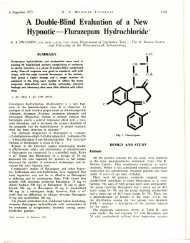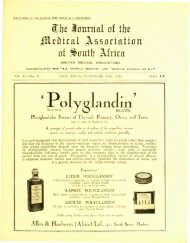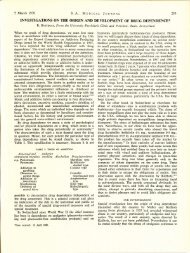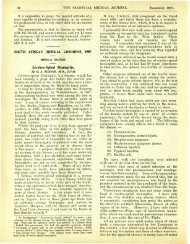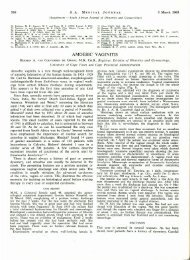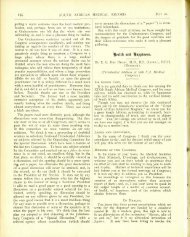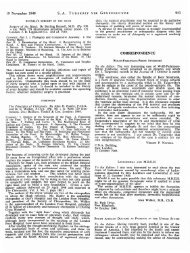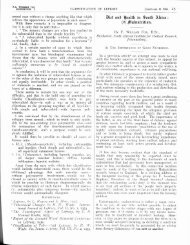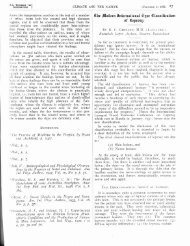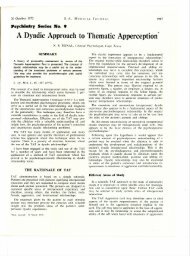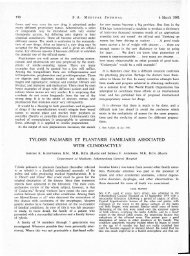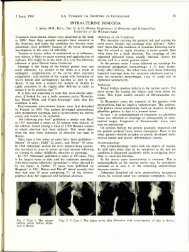Chorio-amnionitis in relation to mode of delivery at term
Chorio-amnionitis in relation to mode of delivery at term
Chorio-amnionitis in relation to mode of delivery at term
Create successful ePaper yourself
Turn your PDF publications into a flip-book with our unique Google optimized e-Paper software.
202 SAMT VOL 76 2 SEPT 1989<br />
Results<br />
A m<strong>at</strong>ernal <strong>in</strong>flamma<strong>to</strong>ry response (membranitis or subchorionic<br />
<strong>in</strong>tervillositis) was present <strong>in</strong> 14 vag<strong>in</strong>al deliveries (28%)<br />
and 3 caesarean sections (6%). This difference was significant<br />
(X 2 = 7,09; P < 0,01). Of the 50 placentas delivered vag<strong>in</strong>ally,<br />
membranitis was present <strong>in</strong> 12 and <strong>in</strong>tervillositis <strong>in</strong> 9, with 7<br />
placentas hav<strong>in</strong>g both membranitis and <strong>in</strong>tervillositis. Three <strong>of</strong><br />
the 50 placentas delivered by caesarean section had <strong>in</strong>tervillositis,<br />
<strong>of</strong> which 2 also had a membranitis. In all cases with a<br />
fetal response, a m<strong>at</strong>ernal response was also present.<br />
In contrast, a fetal <strong>in</strong>flamma<strong>to</strong>ry response (funicitis or<br />
chorionic vasculitis) was present <strong>in</strong> the placentas <strong>of</strong> 6 vag<strong>in</strong>al<br />
deliveries (12%) and 3 caesarean sections (6%). This difference<br />
was not significant (X = 2 0,49; P > 0,05). In the vag<strong>in</strong>al<br />
deliveries, funicitis and chorionic vasculitis were present <strong>in</strong> 4<br />
and 5 cases respectively. In the caesarean sections, funicitis<br />
was present <strong>in</strong> all 3 cases, <strong>of</strong> which 2 also had a chorionic<br />
vasculitis. The <strong>in</strong>fants were all cl<strong>in</strong>ically well without signs <strong>of</strong><br />
bacterial <strong>in</strong>fection <strong>at</strong> <strong>delivery</strong>.<br />
A m<strong>at</strong>ernal <strong>in</strong>flamma<strong>to</strong>ry response was therefore significantly<br />
more frequent after vag<strong>in</strong>al <strong>delivery</strong> than caesarean section,<br />
but there was no significant difference <strong>in</strong> the <strong>in</strong>cidence <strong>of</strong> a<br />
fetal response.<br />
Discussion<br />
Dur<strong>in</strong>g pregnancy the <strong>in</strong>tra-uter<strong>in</strong>e cavity and its contents are<br />
usually sterile and the closed cervix is able <strong>to</strong> prevent an<br />
ascend<strong>in</strong>g spread <strong>of</strong> bacteria from the vag<strong>in</strong>a. However, <strong>in</strong><br />
some cases bacteria are able <strong>to</strong> penetr<strong>at</strong>e the cervical barrier<br />
and migr<strong>at</strong>e between the layers <strong>of</strong> the peripheral membranes<br />
<strong>to</strong> reach the placenta. This evokes an acute <strong>in</strong>flamma<strong>to</strong>ry<br />
response by the mother <strong>in</strong> the chorion, amnion and placenta.<br />
L<strong>at</strong>er the bacteria may colonise the amniotic fluid and stimul<strong>at</strong>e<br />
an <strong>in</strong>flamma<strong>to</strong>ry response by the fetus <strong>in</strong> the umbilical and<br />
chorionic vessels. Only occasionally is the fetus <strong>in</strong>fected.<br />
Therefore the newborn <strong>in</strong>fant is usually cl<strong>in</strong>ically well after<br />
<strong>delivery</strong> despite the presence <strong>of</strong> pus cells and bacteria <strong>in</strong> the<br />
gastric aspir<strong>at</strong>e <strong>at</strong> <strong>delivery</strong> and an <strong>in</strong>flamma<strong>to</strong>ry <strong>in</strong>fIltr<strong>at</strong>e ef<br />
the placenta and membranes on his<strong>to</strong>logical exam<strong>in</strong><strong>at</strong>ion.<br />
The ability <strong>of</strong> the cervix <strong>to</strong> prevent the ascend<strong>in</strong>g spread <strong>of</strong><br />
bacteria before the onset <strong>of</strong> labour is supported by this study<br />
where an <strong>in</strong>flamma<strong>to</strong>ry response <strong>in</strong> the placenta, membranes<br />
and umbilical cord was uncommon <strong>in</strong> pregnancies <strong>term</strong><strong>in</strong><strong>at</strong>ed<br />
by elective caesearean section before the onset <strong>of</strong> labour. In<br />
the 3 exceptions, dil<strong>at</strong><strong>at</strong>ion <strong>of</strong> the cervix with exposure <strong>of</strong> the<br />
membranes <strong>to</strong> the vag<strong>in</strong>al flora before the onset <strong>of</strong> contractions<br />
may have allowed colonis<strong>at</strong>ion <strong>of</strong> the uter<strong>in</strong>e cavity.<br />
In contrast, chorio-<strong>amnionitis</strong> was present <strong>in</strong> the placentas<br />
<strong>of</strong> 28% <strong>of</strong> the vag<strong>in</strong>al <strong>delivery</strong> p<strong>at</strong>ients confIrm<strong>in</strong>g th<strong>at</strong> <strong>in</strong>fection<br />
<strong>of</strong> the placenta and membranes is commonly associ<strong>at</strong>ed with<br />
the spontaneous onset <strong>of</strong> labour and vag<strong>in</strong>al <strong>delivery</strong>.<br />
It is thought th<strong>at</strong> bacterial <strong>in</strong>vasion <strong>of</strong> the amnion, chorion<br />
and decidua stimul<strong>at</strong>es the production <strong>of</strong> prostagland<strong>in</strong>s, which<br />
<strong>in</strong>iti<strong>at</strong>es myometrial contractions. 2 • 4 It is suggested therefore<br />
th<strong>at</strong> bacterial colonis<strong>at</strong>ion <strong>of</strong> the placenta and membranes,<br />
<strong>of</strong>ten before membrane rupture, is a common cause <strong>of</strong> the<br />
onset <strong>of</strong> labour,s·6 especially <strong>in</strong> pre<strong>term</strong> deliveries.<br />
The fllld<strong>in</strong>gs <strong>of</strong> this study - th<strong>at</strong> a m<strong>at</strong>ernal <strong>in</strong>flamma<strong>to</strong>ry<br />
response is unusual before, but common after, labour and<br />
vag<strong>in</strong>al <strong>delivery</strong> - support the hypothesis th<strong>at</strong> bacterial colonis<strong>at</strong>ion<br />
<strong>of</strong> the <strong>in</strong>tra-uter<strong>in</strong>e cavity may play a role <strong>in</strong> the<br />
<strong>in</strong>iti<strong>at</strong>ion or ma<strong>in</strong>tenance <strong>of</strong> labour <strong>at</strong> <strong>term</strong>. However, the<br />
<strong>in</strong>frequent fInd<strong>in</strong>g <strong>of</strong> a fetal response suggests th<strong>at</strong> the chorio<strong>amnionitis</strong><br />
is <strong>of</strong> short dur<strong>at</strong>ion as it had not progressed <strong>to</strong> the<br />
stage <strong>of</strong> amniotic fluid colonis<strong>at</strong>ion with <strong>in</strong>flamm<strong>at</strong>ion <strong>in</strong> the<br />
umbilical and chorionic vessels. Therefore the <strong>in</strong>flamma<strong>to</strong>ry<br />
changes noted probably reflect bacterial colonis<strong>at</strong>ion <strong>of</strong> the<br />
placenta and membranes, occurr<strong>in</strong>g with dil<strong>at</strong><strong>at</strong>ion <strong>of</strong> the<br />
cervix and exposure or rupture <strong>of</strong> the membranes dur<strong>in</strong>g the<br />
course <strong>of</strong> labour.<br />
It is concluded th<strong>at</strong> chorio-<strong>amnionitis</strong> is uncommon before<br />
the onset <strong>of</strong> labour <strong>at</strong> <strong>term</strong>. In contrast, it is signifIcantly more<br />
frequent after spontaneous vag<strong>in</strong>al <strong>delivery</strong>, suggest<strong>in</strong>g th<strong>at</strong><br />
bacterial colonis<strong>at</strong>ion <strong>of</strong> the placenta and membranes frequently<br />
takes place dur<strong>in</strong>g labour.<br />
REFERENCES<br />
l. Blanc WA. Amniotic <strong>in</strong>fection syndrome - parhogenesis, morphology and<br />
SIgnificance ill orcumn<strong>at</strong>al mortality. elm Obscet Gyneco/1959; 2: 705-734.<br />
2. Bejar P, Curbelo V, Davis C, Glue!< L. Prem<strong>at</strong>ure labour: H. Bacterial<br />
sources <strong>of</strong> phospholipase. Obstet Gyneco/1981; 57: 479-482.<br />
3. Blanc WA. P<strong>at</strong>hology <strong>of</strong> the placenta, membranes, and umbilical cord <strong>in</strong><br />
bacterial fungal and viral <strong>in</strong>fections <strong>in</strong> man. In: Naeye RL, Kissane JM,<br />
Kaufman N, eds. Per<strong>in</strong><strong>at</strong>al Diseases. Baltimore: Williams & Wilk<strong>in</strong>s, 1981:<br />
67-132.<br />
4. Lamont RF, Rose M, Elder MG. Effect <strong>of</strong> bacterial products on prostagland<strong>in</strong>-E<br />
prodltction by amnion cells. Lancet 1985; 2: 1331-1333.<br />
5. Bob<strong>in</strong> JR, Hayslip CC, Damaro ]D. Anmiotic fluid <strong>in</strong>fection as de<strong>term</strong><strong>in</strong>ed<br />
by transabdom<strong>in</strong>al amniocentesis <strong>in</strong> p<strong>at</strong>ients with <strong>in</strong>tact membranes <strong>in</strong><br />
prem<strong>at</strong>ure labor. Am] Obstet Gyneco/1981; 140: 947-952.<br />
6. Naeye RL, Peters EC. Anmioric fluid <strong>in</strong>fections wirh <strong>in</strong>tact membranes<br />
lead<strong>in</strong>g <strong>to</strong> per<strong>in</strong><strong>at</strong>al dearhs: a prospective study. Pedi<strong>at</strong>rics 1978; 61: 171-177.



